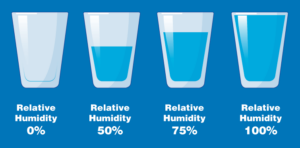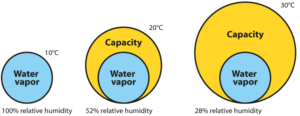Understanding Relative Humidity
As a homeowner, understanding relative humidity (RH) is essential for maintaining a comfortable and healthy living environment. Whether it’s ensuring your family’s comfort, protecting your home from moisture-related issues, or preserving valuable belongings, knowing the basics of relative humidity is crucial. In this post, we will explore the fundamentals of relative humidity, its significance for homeowners, and practical tips for managing it effectively.
What is Relative Humidity
Relative humidity refers to the amount of moisture present in the air compared to the maximum amount of moisture the air can hold at a specific temperature. It is measured as a percentage and determines the air’s water vapor saturation level. Relative humidity impacts the comfort level inside your home and influences various aspects of your living space.

Understanding the Relationship with Temperature
Temperature plays a significant role in relative humidity. Warm air can hold more moisture compared to cool air. This means that the relative humidity will vary based on the temperature. For instance, the same amount of water vapor can result in a higher relative humidity in cooler air than in warmer air.

The Significance of Dew Point
Dew point is a critical concept related to relative humidity. It represents the temperature at which the air becomes saturated and condensation occurs. When the air reaches its dew point, the relative humidity is 100%. If the temperature falls below the dew point, moisture starts to condense, leading to dew, fog, or even frost.
Measuring Relative Humidity
Monitoring relative humidity is crucial for maintaining a healthy indoor environment. You can use a hygrometer, a device specifically designed to measure moisture. There are different types of hygrometers available for homeowners, such as digital hygrometers, which provide a direct reading of relative humidity, making it easy for you to track and manage moisture levels in your home.
Impact on Home and Occupants
Understanding relative humidity is vital for homeowners due to its impact on various aspects of your living space:
1. Comfort and Energy Efficiency: High humidity levels can make your home feel hot and sticky, making it uncomfortable for you and your family. By managing relative humidity, you can improve indoor comfort and reduce the reliance on air conditioning, leading to energy savings.
2. Mold and Mildew Prevention: Excessive humidity can create a favorable environment for mold and mildew growth, leading to structural damage and health issues. Maintaining optimal moisture levels helps prevent these problems and ensures a healthy living environment.
3. Wood Flooring and Furniture: Fluctuations in humidity can cause wood flooring to expand or contract, leading to warping or gaps. Similarly, wooden furniture can be affected by extreme humidity levels. By controlling relative humidity, you can protect your investments and extend their lifespan.
4. Electronics and Appliances: High humidity levels can adversely affect electronic devices and appliances, causing corrosion and malfunction. Maintaining an optimal relative humidity range safeguards your valuable electronics and extends their lifespan.
Practical Tips for Managing Relative Humidity
Here are some actionable tips for homeowners to manage relative humidity effectively:
1. Use Dehumidifiers: Dehumidifiers help reduce excess moisture in the air, especially in damp areas such as basements or bathrooms. They are particularly useful in humid climates or during rainy seasons.
2. Ventilation: Proper ventilation, such as using exhaust fans in kitchens and bathrooms, helps remove excess humidity and prevent condensation.
3. Air Conditioning: Air conditioning not only cools the air but also dehumidifies it. Running your air conditioner during humid periods can help maintain optimal humidity levels.
4. Monitor and Maintain: Regularly check your hygrometer to monitor relative humidity levels in different areas of your home. Aim for a range between 30% and 50% for optimal comfort and to prevent moisture-related damage.
Relative humidity is a key factor in understanding our environment and its impact on our well-being. By comprehending the basics of relative humidity, we can make informed decisions, whether it’s adjusting our home’s climate, planning outdoor activities, or preserving valuable possessions. Remember, maintaining an optimal relative humidity level is essential for our comfort, health, and the preservation of our surroundings.
Looking to fix humidity problems in your home? Give yourself the peace of mind you deserve. Call the team at DocAir to schedule a free consultation on dehumidification systems and moisture management today. We can’t wait to hear from you!


